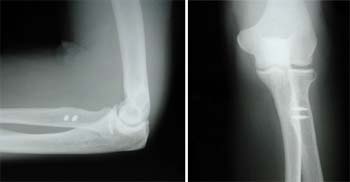Biceps Tendon Tear at the Elbow The biceps muscle is in the front of your upper arm. It helps you bend your elbow and rotate your forearm. It also helps keep your shoulder stable.
Tendons attach muscles to bones. Your biceps tendons attach the biceps muscle to bones in the shoulder and in the elbow. If you tear the biceps tendon at the elbow, you will lose strength in your arm and be unable to forcefully turn your arm from palm down to palm up.
Once torn, the biceps tendon at the elbow will not grow back to the bone and heal. Other arm muscles make it possible to bend the elbow fairly well without the biceps. However, they cannot fulfill all the functions, especially the motion of rotating the forearm from palm down to palm up. This is called supination. Significant, permanent weakness during supination will occur if this tendon is not surgically repaired.
Anatomy
The biceps has two tendons that attach the muscle to the bone in the shoulder and one tendon that attaches at the elbow. The tendon at the elbow is also called the distal biceps tendon. It attaches to the radial tuberosity. This is a small bump on one of the bones in your forearm (radius) near your elbow joint.
Description
Biceps tendon tears can be either partial or complete.
Partial tears. These tears do not completely sever the tendon.
Complete tears. A complete tear will split the tendon into two pieces.


In most cases, tears of the distal biceps tendon are complete. This means that the entire muscle is detached from the bone and pulled toward the shoulder. Distal biceps tendon rupture is equally likely in the dominant and non-dominant arm.
Other arm muscles can substitute for the injured tendon, usually resulting in full motion and reasonable function. Left without surgical repair, however, the injured arm will have a 30% to 40% decrease in strength, mainly in twisting the forearm (supination).
Rupture of the biceps tendon at the elbow is unusual. It occurs in only one to two people per 100,000 each year, and rarely in women.
Cause
The main cause of a distal biceps tendon tear is a sudden injury. These tears are rarely associated with other medical conditions.
Injury
Injuries to the biceps tendon at the elbow usually occur when the elbow is forced straight against resistance. It is less common to injure this tendon when the elbow is forcibly bent against a heavy load.
Lifting a heavy box is a good example. Perhaps you grab it without realizing how much it weighs. You strain your biceps muscles and tendons trying to keep your arms bent, but the weight is too much and forces your arms straight. As you struggle, the stress on your biceps increases and the tendon tears away from the bone.
Risk Factors
Men, age 30 years or older, are most likely to tear the distal biceps tendon.
Additional risk factors for distal biceps tendon tear include:
Smoking. Nicotine use can affect nutrition in the tendon.
Corticosteroid medications. Using corticosteroids has been linked to increased muscle and tendon weakness.
Symptoms
A distal biceps tendon tear can cause the muscle to ball up near the shoulder. Bruising at the elbow is also common.
There is often a “pop” at the elbow when the tendon ruptures. Pain is severe at first, but may subside after a week or two. Other symptoms include:
- Swelling in the front of the elbow
- Visible bruising in the elbow and forearm
- Weakness in bending of the elbow
- Weakness in twisting the forearm (supination)
- A bulge in the upper part of the arm created by the recoiled, shortened biceps muscle
- A gap in the front of the elbow created by the absence of the tendon
Doctor Examination
Medical History and Physical Examination
After discussing your symptoms, your doctor will review the events of the injury to determine how it occurred. During the physical examination, your doctor will feel the front of your elbow, looking for a gap in the tendon. He or she will test the supination strength of your forearm by asking you to rotate your forearm against resistance. Your doctor will compare the supination strength to the strength of your opposite, uninjured forearm.
In addition to the examination, your doctor may recommend imaging tests to help confirm a diagnosis.
Imaging Tests
X-rays. Although X-rays cannot show soft tissues like the biceps tendon, they can be useful in ruling out other problems that can cause elbow pain.
Magnetic resonance imaging (MRI). These scans create better images of soft tissues. They can show both partial and complete tears.
Treatment
Nonsurgical Treatment
Nonsurgical treatment may be considered for patients who are elderly and inactive, or who have medical problems that make them high-risk for modest surgery.
Patients must weigh the decision to proceed with nonsurgical treatment carefully, because restoring arm function with later surgery may not be possible.
The tendon should be repaired during the first 2 to 3 weeks after injury. After this time, the tendon and biceps muscle begin to scar and shorten.
While other options are available for patients requesting late surgical treatment for this injury, they are more complicated and generally less successful.
Surgical Treatment
Procedure. Doctors use several procedures to reattach the distal biceps tendon to the forearm bone. Some doctors prefer to use two incisions, while others only one incision. There are pros and cons to each approach.
Sometimes the tendon is attached with stitches through holes drilled in the bone. Other times, small metal implants are used to attach the tendon to the bone.
Be sure to carefully discuss the options available with your doctor.
X-rays showing metal implants called suture anchors that have been used to secure the biceps tendon to the bone.
Complications. Surgical complications are generally rare and temporary. They occur in about 6% to 9% of patients.
- Numbness and/or weakness in the forearm can occur and usually goes away.
- New bone may develop around the site where the tendon is attached to the forearm bone. While this usually causes little limitation of movement, sometimes it can reduce the ability to twist the forearm. This requires additional surgery.
- Rerupture after full healing of the repair is uncommon.
Rehabilitation. Right after surgery, your arm may be immobilized in a cast or splint.
Your doctor will soon begin having you move your arm, often with the protection of a brace. He or she may prescribe physical therapy to help you regain range of motion and strength.
Resistance exercises, such as lightly contracting the biceps or using elastic bands, may be gradually added to your rehabilitation plan.
Be sure to follow your doctor’s treatment plan. Since the biceps tendon takes 2 to 3 months to fully heal, it is important to protect the repair by restricting your activities.
Light work activities can begin soon after surgery. But heavy lifting and vigorous activity should be avoided for several months.
Although it is a slow process, your commitment to your rehabilitation plan is the most important factor in returning to all the activities you enjoy.
Surgical Outcome. Almost all patients have full range of motion at the final follow-up doctor visit.
After time, return to heavy activities and jobs involving manual labor is a reasonable expectation.
Co-developed by the American Shoulder and Elbow Surgeons
Co-developed by the American Orthopaedic Society for Sports Medicine
AAOS does not endorse any treatments, procedures, products, or physicians referenced herein. This information is provided as an educational service and is not intended to serve as medical advice. Anyone seeking specific orthopaedic advice or assistance should consult his or her orthopaedic surgeon, or locate one in your area through the AAOS “Find an Orthopaedist” program on this website.
program on this website.


